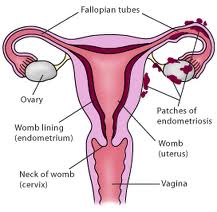Endometriosis means the presence of endometrium in sites other than the uterine lining (ectopic endometrium). Usually, the ectopic sites are the peritoneum (lining of the pelvic cavity) or the ovaries. It may consist of only a few small flecks of ectopic endometrium or there may be massive amounts of endometrium in the pelvis.
The cause of endometriosis is still not proven, although several hypotheses have been proposed. The most commonly accepted theory is that there is flow of menstrual blood containing living cells from the endometrium back through the tubes, allowing endometrium to implant and grow in an abnormal site.
Approximately 5% of women have endometriosis. Endometriosis may be associated with severe pelvic pain in some women, while some have no pain. In addition, many women with endometriosis are infertile, probably the most common reason a physician sees them. Such women, except those with very extensive disease, are not sterile, and pregnancy can occur, although with a much reduced frequency.
The reason women with endometriosis are infertile is still unknown, although several mechanisms have been proposed. Perhaps the most commonly accepted proposal is that endometriosis causes an inflammatory response in the pelvis, and interferes with either fertilization or egg and sperm transport in the woman’s tubes. Others have proposed that the abnormal uterine contractions may interfere with sperm transport. Whatever the mechanism, it is clear that many women with endometriosis have difficulty becoming pregnant.
Treatment
Several regimes for treatment are available, none of which are completely satisfactory. They will be discussed separately.
- Danazol: Danazol was introduced in the 1970s, and initially was thought to have great promise for treatment of infertility. It is a drug with weak androgen effects that suppress production of hormones from the pituitary gland that stimulate the ovaries. It also interferes with the ability of tissues, including the endometriosis, to respond to the effect of estrogen, the female hormone. Without the effect of estrogen, endometriosis tends to regress. While there was early optimism that danazol might increase the probability of pregnancy, those hopes have been proven to be incorrect, and danazol may actually reduce pregnancy rates, although it is sometimes effective for relief for pain. Side effects that have been reported include growth of facial hair in some women, and occasional deepening of the voice.
- Lupron: Lupron is a drug that causes the pituitary gland to stop making hormones that stimulate the ovaries, thus inducing a temporary menopause. Without estrogen, the endometriosis regresses to some extent, but does not disappear completely. The early optimism that it would be a good drug for treatment of infertility was not sustained, and it probably reduces pregnancy rates. However, it is often used for pain relief, although the pain usually recurs after a variable period of time. Side effects include menopausal symptoms with vaginal dryness and hot flashes. The most disturbing side effect is bone loss similar to that seen in menopause. Fortunately, the bone mass is replaced, but except in unusual patients the drug is not used more than six months in any particular course of treatment.
Surgical Treatment
Endometriosis has been treated with surgery for many years, and still remains the treatment of choice in women who have intractable pain and who have completed their childbearing. Hysterectomy and removal of the ovaries is the only means by which permanent relief can be obtained. However, this is not an option in women who desire childbearing.
Surgical treatment in women with infertility has been disappointing. Laparoscopy with removal, cautery or laser of the lesions has been shown by some to improve pregnancy rates and by others to have no impact on rates. At any rate, surgical treatment has not been shown to convert pregnancy rates to normal, although some studies have shown some improvement.
Ovarian endometriomas (cystic areas of endometriosis in the ovary) probably should be excised by way of laparoscopy before embarking on in vitro fertilization.
Emperic Treatment
The most effective treatment of infertility in women with endometriosis is by one of the assisted reproductive technologies. Treatment with fertility drugs (clomiphene, follistim, gonal F) followed by intrauterine insemination gives pregnancy rates of 12% – 18% per cycle, and the better in vitro fertilization clinics report pregnancy rates up to 65% per cycle, depending on the woman’s age, semen characteristics and other factors.
Summary
Endometriosis is still an enigmatic disease. While permanent cure is usually not possible, the woman can usually obtain pain relief, and with proper treatment, the prognosis for pregnancy is good.
To learn more or schedule a consultation:
Call (919) 233-1680 or

